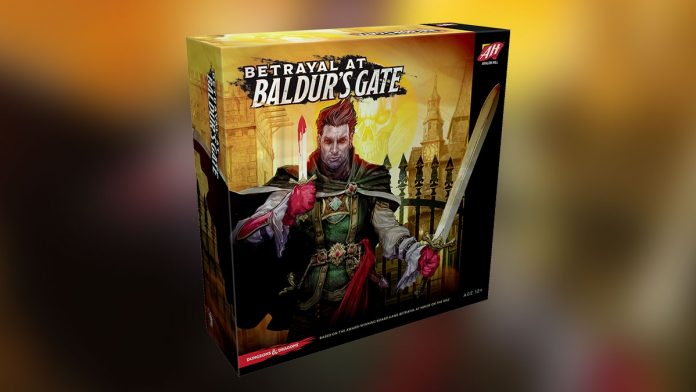You don’t get many opportunities to ask your friends whether they want you to bite them, because you just got bitten by a wererat, and maybe they want to as well, but Betrayal at Baldur’s Gate sure is one of them. The new board game is a remake and reskin of Betrayal at House on the Hill, which has become something of a modern classic in the board game world since its release 14 years ago.
But while House has a team of three to six players exploring a haunted mansion to uncover secrets, treasures, and — unfortunately for them — monsters, this new spinoff transposes the action to the fantasy city of Baldur’s Gate, a popular Dungeons & Dragons locale, and host to multiple beloved PC role-playing games. The shift from modern to medieval hasn’t lessened the focus on horror, however: adventurers braving the streets and catacombs of Baldur’s Gate should expect to emerge physically and mentally scarred, if they emerge at all.
The game is built around exploration: each player moves their character (each character having varying levels of mastery at the game’s four attributes: speed, might, sanity, and knowledge, as well as a unique character-specific ability) around a map, drawing new rooms from a deck to build the board as they go. Players all work cooperatively, but there’s an air of paranoia from the beginning, because everyone knows that eventually, inevitably, one player will betray the rest. Who it will be is unknown (it comes down to luck of the draw around the midpoint in the game), but nobody trips over themselves to share the beneficial treasure cards they discover with their fellow players too soon, preferring to hold onto them just in case.
Once the game reaches its turning point, and one player turns traitor, one of the game’s 50 random scenarios is selected, offering a specific storyline for that particular game, and two sets of rules and objectives: one for the traitor, and another for the remaining players. The different scenarios are varied, and represent a range of fantasy tropes, each with its own unique rules, and some with wildly different play styles.
Betrayal at Baldur’s Gate shares some of the same weaknesses as the original Betrayal at House on the Hill, as is to be expected — the game is markedly better and more interesting in direct proportion to a larger number of participating players, ideally a full six. In addition, while its basic rules are relatively easy to pick up, each scenario (or “haunt,” as they’re called) offers unique rules which can be confusing even for experienced players. A laid-back group who can settle on a fair solution to a rules question will have much more fun than one who wants to debate the correct interpretation.
That said, Baldur’s Gate does make some improvements on the original House formula. The game board is divided up into two “layers” — the city streets/buildings, and the catacombs beneath. House had three: a basement, ground floor, and upper floor (as well as an attic in the game’s expansion, Widow’s Walk), which meant the game sometimes required a massive amount of table space, and became a confusing maze. In addition, the new setting freshens things up for those getting tired of exploring the same haunted house with the same spooky omens cropping up on a regular basis. Of course, Baldur’s Gate will become familiar as well, but it offers a change of pace, and an alternate option.
The game’s cooperative nature, combined with the paranoia of the traitor, lead to a tense but relatively non-competitive atmosphere compared to most board games. Sure, it becomes everyone versus one player, but there’s a sense that the player had bad luck, and was put there by the game, and it could easily have been anyone else, so it’s hard to take it too personally. The pacing is also immaculate: games almost uniformly take within 20 minutes of an hour one way or the other, and rarely slow down to drag (though I must confess, I haven’t yet tried the majority of the 50 scenarios — some of House’s did vary in quality, and no doubt Baldur’s Gate’s do as well), with the potential for games to come down to a single roll of a die.
While the Dungeons & Dragons flavour may not appeal to as broad of an audience as a haunted house, D&D fans will certainly appreciate lots of references to classic elements of the roleplaying game (as well as the Baldur’s Gate computer games), and the addition of unique classes and small backstories for each character are a nice nod towards the roleplaying potential, even if the rules aren’t explicit about it.
If you feel like spending an evening trapped in a terrifying mansion with your friends waiting for one to stab you in the back, Betrayal at House on the Hill is a good time. But if you’d prefer to spend it travelling through taverns and catacombs looking for the Apparatus of Kwalish, and running from mind flayers (and then getting blasted in the back by a spell from one of your friends), give Betrayal at Baldur’s Gate a look.
Image: Avalon Hill
Jeff was The Cascade's Editor in Chief for the latter half of 2022, having previously served as Digital Media Manager, Culture & Events Editor, and Opinion Editor. One time he held all three of those positions for a month, and he's not sure how he survived that. He started at The Cascade in 2016.



